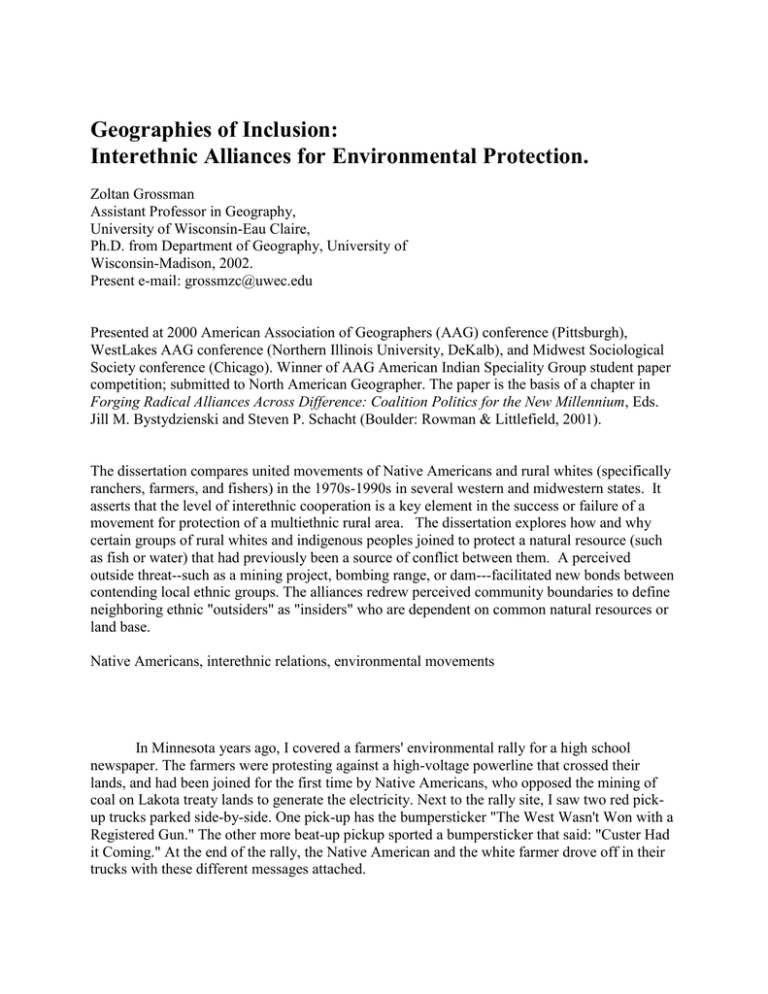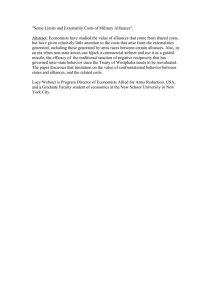Geographies of Inclusion: Interethnic Alliances for Environmental Protection.
advertisement

Geographies of Inclusion: Interethnic Alliances for Environmental Protection. Zoltan Grossman Assistant Professor in Geography, University of Wisconsin-Eau Claire, Ph.D. from Department of Geography, University of Wisconsin-Madison, 2002. Present e-mail: grossmzc@uwec.edu Presented at 2000 American Association of Geographers (AAG) conference (Pittsburgh), WestLakes AAG conference (Northern Illinois University, DeKalb), and Midwest Sociological Society conference (Chicago). Winner of AAG American Indian Speciality Group student paper competition; submitted to North American Geographer. The paper is the basis of a chapter in Forging Radical Alliances Across Difference: Coalition Politics for the New Millennium, Eds. Jill M. Bystydzienski and Steven P. Schacht (Boulder: Rowman & Littlefield, 2001). The dissertation compares united movements of Native Americans and rural whites (specifically ranchers, farmers, and fishers) in the 1970s-1990s in several western and midwestern states. It asserts that the level of interethnic cooperation is a key element in the success or failure of a movement for protection of a multiethnic rural area. The dissertation explores how and why certain groups of rural whites and indigenous peoples joined to protect a natural resource (such as fish or water) that had previously been a source of conflict between them. A perceived outside threat--such as a mining project, bombing range, or dam---facilitated new bonds between contending local ethnic groups. The alliances redrew perceived community boundaries to define neighboring ethnic "outsiders" as "insiders" who are dependent on common natural resources or land base. Native Americans, interethnic relations, environmental movements In Minnesota years ago, I covered a farmers' environmental rally for a high school newspaper. The farmers were protesting against a high-voltage powerline that crossed their lands, and had been joined for the first time by Native Americans, who opposed the mining of coal on Lakota treaty lands to generate the electricity. Next to the rally site, I saw two red pickup trucks parked side-by-side. One pick-up has the bumpersticker "The West Wasn't Won with a Registered Gun." The other more beat-up pickup sported a bumpersticker that said: "Custer Had it Coming." At the end of the rally, the Native American and the white farmer drove off in their trucks with these different messages attached. Seeing those two pick-ups drove me to study why Native Americans and rural EuroAmerican residents-archetypal enemies in past and present land rights conflicts-would find common cause to defend their mutual place. In the 1970s, similar alliances brought together Native Americans and rural whites in some of the most unlikely areas where they could be be imagined. Farmers, ranchers, commercial fishers and sportfishers had been at odds with Native nations over the control of land and resources. Yet in an evolution that continues today, members of the communities unexpectedly came together to protect the environment from a perceived outside threat. Interethnic cooperation has become an element in the protection of multiethnic rural places. The central question in my dissertation case studies is how and why these people joined to protect land or resources that had been a source of conflict between them. Social scientists often study ethnic or racial conflict, but few have studied examples of cooperation based on common interests. Even fewer have looked at these questions in the context of a common sense of place. The evolution went through four general and often overlapping stages. First, Native American nations asserted their autonomy. Second, a backlash emerged from some rural whites over proper resource use. Third, the two groups initiated dialogue over a perceived outside threat to the resources. Finally, the groups began to cooperate. To sum it up, the neighboring groups felt that if they continued to contest the place, to fight over resources, there may not be any left to fight over. I have not looked at the technical aspects of why the groups saw an environmental threatthe perception is enough for the purposes of the study-but rather at the "positionality" of the actors in the conflict. I have so far interviewed more than 80 members of these alliances, asking them how the communities evolved from confrontation to cooperation, how the locale and sense of place affected the evolution, and what if any lasting changes in community relationships have resulted. These interethnic environmental alliances began in the West in the mid-1970s, and have since gradually migrated into the Midwest. In my dissertation, I briefly examine alliances against mines, dams, logging, powerlines, nuclear waste, military projects, and other environmental issues in the Northwest, Nevada, Montana, South Dakota (where one of the groups was called the Cowboy and Indian Alliance), Minnesota, and southern Wisconsin. But my central case study is the still unfolding alliance between sportfishing groups and the Ojibwe (or Chippewa) against proposed metallic sulfide mines in three watersheds in northern Wisconsin. Northern Wisconsin was the scene of an intense conflict in the late 1980s and early 1990s between Ojibwe spearfishers and white sportfishers. Under two treaties, the tribes had reserved use rights to off-reservation natural resources in their ceded territories-such as fish, game, wild rice, and medicinal plants. Anti-treaty protesters held signs reading "save a walleye--spear an Indian." National Guard helicopters, Department of Natural Resources (or DNR) patrol boats, and riot-ready police from around the state were deployed at the boat landings. Incidents of violence--such as rock and bottle throwing, sniper fire, pipe bombs, attacks on boats and vehicles, etc.--entered around the Lac du Flambeau Reservation in north-central Wisconsin. The second-largest spearing contingent was from the Mole Lake Reservation, in northeastern Wisconsin. The one reservation that scaled back its off-reservation spearing was Lac Courte Oreilles, in northwestern Wisconsin, to prevent friction with sportfishers and resort owners. Wisconsin's spearfishing conflict became a classic case of what David Sibley terms the "geographies of exclusion." The Ojibwe were said to be fishing in the wrong place (off the reservation) because the stereotype located the minority group on the reservation. Indeed, one common anti-treaty chant was the ironic statement "Indians go home." Similarly, Tim Cresswell's studies of social transgression would clearly identify the Ojibwe as "outsiders" when they leave the reservation boundaries, and the rural white sportsmen as the self-proclaimed exclusive "insiders" within the ceded territory. Yet what neither Sibley nor Cresswell anticipated was the arrival of a third party onto the landscape, attracting both groups' definition of a new and more threatening "outsider." By the early 1990s, treaties became a factor in the controversy over the growing activity of mining companies in the ceded territory. The treaties do not cover mineral rights, but the tribes interpret their guarantees to mean that any degradation of off-reservation resources would be an "environmental violation" of the treaties, giving them legal standing in federal court to challenge harmful projects. Even during the spearing clashes, Red Cliff Ojibwe environmental leader Walter Bresette had predicted that northerners would realize that environmental and economic problems are "more of a threat to their lifestyle than Indians who go out and spear fish....we have more in common with the anti-Indian people than we do with the state of Wisconsin." By 1992, increased education on fish biology and a federal court injunction against antiIndian harassment lessened treaty confrontations. A U.W.-Madison survey showed that 58 percent of northern residents favored the policy of closely regulated treaty rights-a change from previous anti-treaty majorities. It was around this same time that the mining companies made their forays. The first interethnic environmental alliance developed in northwestern Wisconsin, against Kennecott's proposed Ladysmith copper-gold mine in Rusk County, on the Flambeau River, 30 miles south of Lac Courte Oreilles. The tribe joined the Sierra Club in a lawsuit to protect endangered species in the river. Yet the coalition developed mainly between environmental group and Lac Courte Oreilles leaders, rather than between local communities. The tribe lacked the funds to appeal after it lost the suit, and the mine opened in 1993. The geography of the watershed offers some explanations. The Flambeau River was far from Lac Courte Oreilles, and the water flowed away from the reservation. Fishing and the riverbased tourism industry had been ruined for years by upstream paper mills; the tribe was mainly concerned about protecting medicine plants rather than fish. The movement had some difficulty mobilizing Rusk County residents because their "sense of place" was not strongly centered on the Flambeau River. Treaty politics offers another explanation. Ladysmith farmer Roscoe Churchill remembers that, while the treaty conflict brought tribal powers "out into the open" elsewhere in the North, around Lac Courte Oreilles the public "didn't have anything to spur them on." Bresette concluded of the Ladysmith loss, "Where you don't have Indian rights, non-Indians lose." The second alliance developed in 1991 in north-central Wisconsin, against Noranda's proposed zinc-silver mine in Oneida County, on the Willow River, about 30 miles south of Lac du Flambeau. The area had been the scene of some of the most intense spearing clashes, but an alliance against the mine nevertheless developed quickly. Local residents invited Lac du Flambeau spearing leader Tom Maulson to join the Environmentally Concerned Citizens of Lakeland Areas (or ECCOLA). By 1992, crowds at DNR mine hearings outnumbered the antitreaty protesters at the boat landings. They included some sportsmen who had been anti-treaty group followers, but did not want mines to dirty their fishing spots. The geography of the Willow River offers some explanations for the alliance. It was the site of a walleye spawning bed valued by anglers and spearers alike. Treaty politics again played a role in the development of the alliance. ECCOLA founder Carolyn Parker asserts that spearing "closed some people's minds but opened others." Maulson says that the conflict offered "an education on everybody's part as to what Indians were about. It needed a conflict to wake them up." Rhinelander fishing guide Wally Cooper came to believe that, because of spearing, governments have made detailed studies of fish resources, and that the Ojibwe have done a better job than the DNR in regulating fish harvests. Noranda dropped its mine plan in 1993 due to wetlands concerns. Today, Lac du Flambeau has several legacies from the spearing and mining alliances. Parker, now a Vilas County Board member, has led support for tribal protection of a burial ground from a condominium development. Maulson, now the tribal chair, has expanded the casino to become the area's economic engine, even employing some former anti-treaty protesters. The third alliance developed in 1992 in northeastern Wisconsin. It opposed Exxon's Crandon zinc-copper mine in Forest County, one mile upstream of the Mole Lake Chippewa Reservation, and 40 miles upstream from the Menominee Reservation, via the Wolf River. Exxon had proposed a mine in 1976, but withdrew in 1986 citing low metal prices. The spearing conflict occurred between Exxon's withdrawal and its 1992 return. Mole Lake and Lac du Flambeau voters also rejected a state government appeal to lease their treaty rights in exchange for money-an offer made by an Administration Secretary who had previously worked for Exxon. Again, the Wolf River's geography offers explanations for the rapid growth of the alliance. Langlade County sportfisher Bob Schmitz says that a "mutual love of the river" brought together angling groups and tribal members. Forest County retiree Tom Ward claims that "There's a mystique about the Wolf," as a Class I trout stream with no significant industry on its banks. Mole Lake tribal member Bill Koenen spoke to a Merrill sportsmen's club meeting in 1996, telling the anglers that "if we don't work together to protect the resource, then we can't fight about walleyes later." He also won the meeting's door prize. George Rock, a Langlade County environmental engineer and sportfisher, remembers that local residents came to see that the sovereign tribes possessed a legal "trump card" that could be used to protect ceded territory. In addition to off-reservation treaty rights, the mine proposal impacts tribal sovereign rights on reservations. The tribes are in the process of enhancing their federal environmental regulatory powers as one barrier to the project. In 1996, Exxon reached a local agreement with a town board for construction of the mine. Angry Nashville township voters not only ousted their three-person board in the next election, but they elected a Mole Lake tribal member to one of the seats, and the new board backed the tribe's battle for federal Clean Water Act authority. Other township and county governemnts passed anti-mine resolutions. In 1998, Exxon sold its share of the project to its Canadian partner Rio Algom. The three Wisconsin Ojibwe case studies show how the differing levels of conflict over resource use in each watershed may have affected the level of cooperation over resource extraction. Native Americans and rural whites found little use in arguing over natural resources that were themselves endangered. The courts' recognition of treaties and sovereign regulations served to equalize political-territorial relations. Racism obviously did not disappear, but organized anti-Indian groups were weakened by the decline of direct conflict and the rise of collaborative strategies. While each of the case studies have their own characteristics, certain patterns can also be detected, explaining why and how the alliances were formed. The explanations can fit into one of three categories: a common sense of place, a common sense of purpose, and a common sense of understanding. First, the most successful of the alliances have developed a "common sense of place." The geographic setting, and the hold that the landscape has on the imaginations of Native Americans and their neighbors, literally helps build "common ground." Groups may be more likely to be bonded in defense of a landscape that both perceive as "sacred"-such as the Willow Flowage or the Wolf River-rather than a landscape where either group sees merely economic potential. The expansion of a sense of community and "insider" status to the other ethnic group may be based partly on the commonly treasured natural feature or resource. The proximity of a reservation to the perceived environmental "threat" also played a role, and on-reservation sovereign rights seemed to be a stronger motivating factor among tribal members than offreservation treaty rights. In addition, environmental protection in general serves as a unifying concept that transcends divisions between ethnic groups. Herb Buettner, Langlade County chair of Trout Unlimited, remembers talking with Native friends in the early 1960s about the Wolf River, and confirming many of their observations when he read Silent Spring. Conversely, Walter Bresette first identified with the land ethic of some rural whites when he first met western Wisconsin farmers. Improved cultural understanding can be both a cause and a result of successful alliances. One Langlade County resident began a program to reintroduce wild rice to his off-reservation lake, and declined to build a home on property that tribal members said was a burial site. The alliances are not simply limited to the issue that initially unified them, but cultural contact has the potential to alter intercommunal relations. Second, the alliances are also often born out of a "common sense of purpose," or the idea that Native Americans and rural whites are "in it together" in legal, political, and economic fields. Tribes that have enhanced their legal powers through treaty or sovereignty struggles are looked upon by many neighbors as possessing "clout" or "aces to play" to protect the environment. Some rural white neighbors assert that strengthened tribal regulations can do a better job in protecting the water than state laws. Common political adversaries are a necessary basis for an interethnic alliance, the most obvious being a company or agency that is planning an objectionable project. Some Ojibwe add that mistrust of the DNR also brought them together with anglers, reflecting their earlier belief that the DNR was pitting them against anglers as "scapegoats" for lowered fish bag limits. Many in both groups contend that an alliance is best built among ordinary people, rather than between tribal and other government officials. The most successful alliances seem to be those opposing state policies, by defending the local place, rather then those supporting state policies. In addition, gaming economically helped even the playing field between Native and nonNative communities in Wisconsin.. Reservation towns used to be economically dependent on white "border towns," but the situation is now often reversed. Gaming income gave tribes access to technical expertise, public relations resources, and respect in the business community, lessening anti-Indian activism and increasing intercultural contacts. Gaming is not, however, as much a factor in my other case studies. Finally, the alliances emerge out of a "common sense of understanding," or a conscious goal of making links between ethnic groups in conflict. The conflict motivated key players to sit down at the table, where they educated each other about their common concerns. An interethnic alliance over anything, however difficult to form, can be viewed as a welcome diversion from continued strife. The initial contact between two communities is almost always made by individuals whose personal history has brought them into contact with the other group, and are thus best able to confront prejudice. Among the key individuals are the few rural whites that have had some prior contact with Native Americans, whether as schoolteachers, nurses, shop owners, or members of mixed families. The trust-building is carried out by these individuals, and is then expanded to the wider community. While the assertion of Native rights seemed to serve as a barrier to interethnic trustbuilding in the short term, it actually helped to facilitate linkages in the long term. With no incentive to listen to their Native neighbors, rural whites would have had little reason to sit down at the table. Facing an unequal relationship with their neighbors, the Native residents likewise would have little incentive to unite with them. Real "unity" has the prerequisite of greater political, cultural, and economic equality, particularly outside reservation boundaries. The treaty rights conflict strengthened the "sense of place" of both groups, by defining the land and its resources as something they needed to defend, and by asserting that both their resource-based ways of life were in some way endangered. As they deconstruct a racially oppressive system based on social groups, they are attempting to reconstruct community based on a defense of common space. In certain areas (such as Lac du Flambeau and Mole Lake), the assertion of Native rights helped to "equalize" the two communities, and thus build better ties between them. In places where an interethnic conflict was prevented or did not occur (such as Lac Courte Oreilles), the later interethnic cooperation was not as fully developed, and the collaborative environmental project may have failed as a result. Cooperation would have certainly been possible without prior conflict, and conflicts do not inevitably lead to collaborative projects. But certain conflicts-in a particular form and met with a particular response-serve as an embryo from which cooperation can emerge. The conflict must have the component of building bridges in the midst of fighting- a conscious effort by ethnic leaders to find common goals. This approach reverses the predominant strategies of ethnic conflict management, which seek to avoid or lessen differences, in order to build unity based on a "lowest-common-denominator." The rural alliances presuppose a common territorial place as the force that can potentially bring together different groups. The territorial definition of the place includes all people who live within it and who depend upon it; in contrast to a social definition of the place that identifies it solely with the ethnic formations that happen to live there. Geographers such as Sibley and Cresswell use the social definition to study the geographies of exclusion, but few have used the territorial definition to study geographies of inclusion. In these cases, inclusion means not an integrationist or assimilationist perspective, but a mutual inclusion of the two communities in place. In northern Wisconsin, Native influence is no longer confined within reservation boundaries, but extends outward to both harvest and protect natural resources. An outside threat has helped to strengthen a territorial place identity over an exclusively ethnic social identity. As Yi-Fu Tuan observes, "We owe our sense of being not only to supportive forces but also to those that pose a threat. Being has a centre and an edge: supportive forces nurture the centre while threatening forces strengthen the edge." This process involves not crossing boundaries, but reconfiguring boundaries. The Ojibwe are no longer simply the "outsiders" who "violate" the boundaries of white communities by spearfishing on "their" lakes. The "outsiders" can become the "insiders," because new and more threatening "outsiders" have appeared on the scene. Members of both ethnic groups have drawn new, larger defensive mental boundaries that view outside institutions as more of a threat to their lifestyle than their ethnic neighbors. The examples of interethnic environmental alliances may be instructive for areas of the world in the grips of communal conflict. Prospects for cooperation can be embedded within conflicts and, under certain circumstances, even harsh interethnic conflict may ironically serve as an opportunity for improving relations between ethnic communities. Most ethnic conflict management strategies rest on cementing a national-scale identity of "state citizenship," which often does not work as a multiethnic identity, or becomes centered on a core ethnic or racial group. A local-scale multiethnic territorial identity, which I will define as "place membership," could be an alternate strategy to "state citizenship" in ethnic conflict management. Place may often serve as an arena of contention and exclusion, but it can also be transformed into a force for inclusion.



